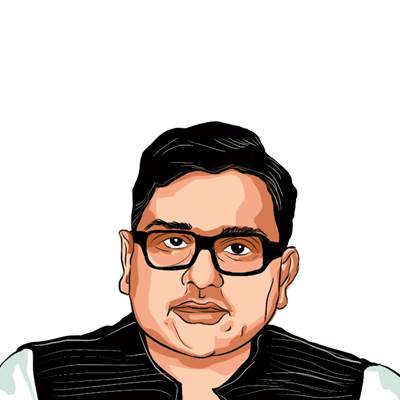Opinion Arvind Kejriwal and hero worship in Indian politics
Kejriwal’s resignation as Delhi chief minister points at the prevalence of personality cults in politics and how they continue to be manipulated for electoral gains
 Former Delhi Chief Minister Arvind Kejriwal. (PTI)
Former Delhi Chief Minister Arvind Kejriwal. (PTI) Arvind Kejriwal’s resignation as Delhi chief minister (CM) can be interpreted in two different ways. The first may be useful to make sense of immediate political calculations. Kejriwal, it seems, has managed to counter the BJP’s aggressive rhetoric of the CM being out on bail. His resignation has given him breathing space to energise the AAP’s campaign in the coming state assembly elections. The resignation episode, in this sense, may be understood as a strategic division of labour. The new CM Atishi is expected to take care of the functioning of the state government in Delhi for a relatively shorter period, while Kejriwal, the face of the AAP, will devote himself to electoral mobilisation.
There is another reading of this development. Kejriwal’s resignation, one may argue, will give him an additional advantage to rework his political image — a key feature of his politics since early 2010s. It is a well-known fact that Kejriwal relies heavily on two related sets of ideas — moral supremacy and systemic victimhood since the days of the India Against Corruption movement. Even at that time, he tried his best to carve out a niche for himself as the most committed and morally superior member of the movement.
The BJP, AAP’s main opponent, especially in Delhi, has always been uncomfortable with Kejriwal’s popular representation as a vocal idealist victim. The party wanted to demonise him in such a way that he could not utilise his image of an aam aadmi in clear political terms. The Delhi liquor case is an example of this. Kejriwal is aware of the fact that the BJP’s active propaganda will create technical as well as political problems for him. In his typical theatrical style, he resigned to reassert his moral authority. It is likely that Kejriwal might project himself as a victim of authoritarianism in the coming election.
These explanations of Kejriwal’s resignation also raise a set of much deeper issues: Do common people relate to the idea of moral sacrifices? Do they accept the self-nurtured positive images of politicians? How do they react to the negative publicity?
To understand these questions, we must recognise an important feature of post-colonial Indian public life. Many observers of Indian politics have argued that political elites represent themselves as morally superior to legitimise their leadership claims. This “saintly” idiom of politics is often associated with M K Gandhi and Vinoba Bhave. However, its prevalence as a strategic move for electoral purposes has not been given sufficient attention.
In recent years, national leaders like Narendra Modi, Kejriwal, Mamata Banerjee and even Rahul Gandhi have made serious attempts to reinvent this political idiom. Modi celebrates his humble socio-economic background to communicate to voters that he does everything for the country. Kejriwal, on the other hand, highlights his image as a victim of a corrupt system. He calls upon the voter to accept him as one of them, an aam aadmi. Rahul Gandhi highlights the fact that his family has been the victim of terrorism. He now asserts his new political identity as an advocate of social justice and equality. Regional leaders also raise similar claims and arguments to get political acceptability.
These examples show that despite growing professionalisation of politics, especially its electoral version, this particular idiom is thriving in public life. However, the nature and substance of it has changed in a significant way. Contemporary politicians tend to produce an interesting configuration to establish a balance between their preferred images as dedicated public figures and professional requirements of electoral politics. Kejriwal, for instance, presents himself as a humble and committed public servant keen to transform the lives of common people; yet, he finds himself surrounded by politicians who do not allow him to achieve his pious objectives. Kejriwal’s resignation is an attempt to regain this positive portrayal. That is the reason why he said that he would not assume the role of CM until he received a “certificate of honesty” from the electorate again.
This portrayal, however, does not go well when we look at the internal power structure of the AAP. Kejriwal has established complete control over the party. Internal democracy, which was highlighted as one of the distinctive features of the AAP, has been systematically replaced by a culture of hero worship. Atishi’s initial comments confirm this — she made it clear that Kejriwal is the “real” CM of Delhi and her objective is to help him regain power again. This image-centricity has become an unwritten norm of politics, which is not specific to the Kejriwal-dominated AAP. One finds very similar trajectories in different parties, especially in the Modi-led BJP.
Does this kind of politics work? There is no clear answer. CSDS-Lokniti-NES 2024 data shows that the image of leaders does play a role in determining the political choice of voters. Modi’s image as a poor chaiwala helped him secure sizeable subaltern support. The success of Bharat Jodo Yatras contributed significantly in creating a new image for Rahul Gandhi as a radical social-justice leader. This is also true for Kejriwal. On the other hand, the electoral verdict of 2024, particularly the BJP’s performance, reminds us that the image of a particular leader does not always help his/her party to win an election. This seemingly contradictory evidence confirms that image-centric professionalism has evolved as a distinct idiom of politics in contemporary India.
The writer is associate professor, CSDS






